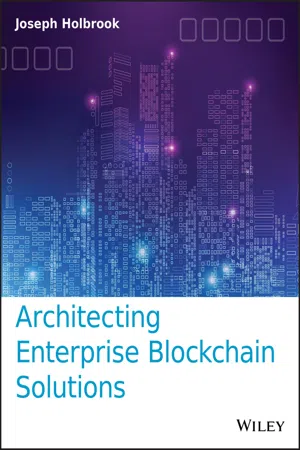
- English
- ePUB (mobile friendly)
- Available on iOS & Android
Architecting Enterprise Blockchain Solutions
About this book
Demystify architecting complex blockchain applications in enterprise environments
Architecting Enterprise Blockchain Solutions helps engineers and IT administrators understand how to architect complex blockchain applications in enterprise environments. The book takes a deep dive into the intricacies of supporting and securing blockchain technology, creating and implementing decentralized applications, and incorporating blockchain into an existing enterprise IT infrastructure.
Blockchain is a technology that is experiencing massive growth in many facets of business and the enterprise. Most books around blockchain primarily deal with how blockchains are related to cryptocurrency or focus on pure blockchain development. This book teaches what blockchain technology is and offers insights into its current and future uses in high performance networks and complex ecosystems.
- Provides a practical, hands-on approach
- Demonstrates the power and flexibility of enterprise blockchains such as Hyperledger and R3 Corda
- Explores how blockchain can be used to solve complex IT support and infrastructure problems
- Offers numerous hands-on examples and diagrams
Get ready to learn how to harness the power and flexibility of enterprise blockchains!
Frequently asked questions
- Essential is ideal for learners and professionals who enjoy exploring a wide range of subjects. Access the Essential Library with 800,000+ trusted titles and best-sellers across business, personal growth, and the humanities. Includes unlimited reading time and Standard Read Aloud voice.
- Complete: Perfect for advanced learners and researchers needing full, unrestricted access. Unlock 1.4M+ books across hundreds of subjects, including academic and specialized titles. The Complete Plan also includes advanced features like Premium Read Aloud and Research Assistant.
Please note we cannot support devices running on iOS 13 and Android 7 or earlier. Learn more about using the app.
Information
Chapter 1
Introduction to Blockchain Technologies
- What a blockchain is and how to define a blockchain
- The history of the blockchain and why the history is important to appreciate
- How blockchains compare to other enterprise technology platforms
- What blockchain transactions are and how they provide value to the enterprise
- What a trustless model is compared to a trust model
- Why the blockchain is considered revolutionary
- Types of blockchain platforms
What Is a Blockchain?
- A blockchain should be a trustless online payment network that is based on peer-to-peer (P2P) versions of electronic cash. The network is a robust node structure that works together with little coordination.
- A blockchain should alleviate the challenge of double spending, where funds can be over drafted and therefore lost to the wallet holder.
- A blockchain should implement the proof-of-work consensus method that rewards nodes that participate in the creation blocks (miners). The miners are rewarded for participation through an incentive approach, and this encourages miners to be honest.
- A blockchain should simplify privacy through a trustless system that removes intermediaries and introduces the use of anonymous public keys.
- A blockchain is a shared distributed ledger or data structure.
- A blockchain is a distributed root of trust on a distributed ledger.
- A blockchain is a digital ledger in which transactions made in Bitcoin or another cryptocurrency are recorded chronologically and publicly.
- A blockchain is a type of distributed ledger for maintaining a permanent and tamper-proof record of transactional data.
- Blockchain technology is a distributed ledger technology that uses a distributed, decentralized, shared, and reciprocal ledger, and it may be public or private, permissioned or permissionless, and driven by tokenized crypto economics or token-less.
My Approach to the Definition
- Technical, which includes IT staff, developers, and other technical stakeholders.
- Business, which are generally IT directors, C-level suite members, and stakeholders of financial organizations.
- Legal, which is generally any compliance-related auditors, corporate counsel, or other types of attorneys. Legal would entail government regulators, as well, depending on your use case.
Technical Audience
Table of contents
- Cover
- Table of Contents
- About the Author
- Acknowledgments
- Foreword
- Introduction
- Chapter 1: Introduction to Blockchain Technologies
- Chapter 2: Enterprise Blockchains: Hyperledger, R3 Corda, Quorum, and Ethereum
- Chapter 3: Architecting Your Enterprise Blockchain
- Chapter 4: Understanding Enterprise Blockchain Consensus
- Chapter 5: Enterprise Blockchain Sales and Solutions Engineering
- Chapter 6: Enterprise Blockchain Economics
- Chapter 7: Deploying Your Blockchain on BaaS
- Chapter 8: Enterprise Blockchain Use Cases
- Chapter 9: Blockchain Governance, Risk, and Compliance (GRC), Privacy, and Legal Concerns
- Chapter 10: Blockchain Development
- Chapter 11: Blockchain Security and Threat Landscape
- Chapter 12: Blockchain Marketplace Outlook
- Index
- End User License Agreement